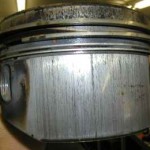
Introduction
It is a very widespread misbelief across tuners that two of the easiest tuning improvements are cutting off the piston skirt and removing the lower piston ring. Most belive that these actions lead to decreased friction which improves cooling and therefore increases the power of an engine. However in most cases these modifications will lead to a piston seizure without any noticeable increase in power.
Why do some pistons have one ring whereas others have two
Especially on high end racing cylinders you’ll find pistons with only one piston ring. Let’s dig into the advantages of a single piston ring first:
- A single piston ring allows for a higher RPM due to reduced friction
- A single piston ring improves cooling due to lower friction
- A single piston ring reduces the likeliness of piston ring issues
However, as always there are also disadvantages when using a single piston ring:
- A single piston ring reduces the compression
- A single piston ring makes the piston unstable
Two important assumptions can be made now when removing the second ring from a two ring piston:
- The piston will last shorter and also stress the cylinder more due to its instability
- The loss of compression needs to be equalized elsewhere
The first assumption explains why we only find single piston ring pistons in aluminum cylinders. Aluminum cylinders have a Nikasil coated surface that makes them more resistant than cast iron cylinders allowing for a higher rpm and more unstable pistons.
The second assumption tells us that we need to take some material off of the cylinder head to achieve at least a similar compression as the engine with two piston rings. Racing cylinder manufacturers have of course taken this into account…
Why do racing pistons have a shorter skirt than original ones
It is not necessarily true that racing pistons always have a shorter skirt. What can be said is that racing pistons never have a piston skirt that is longer than necessary. The secret lies in the question what is necessary. Obviously for an original or eco sport cylinder durability is much more important than for a pure racing cylinder. However, we run again into our cast iron cylinder issue which means that our original cylinders are just too soft to withstand the increased instability of a shortened piston skirt.
What can be done
Minor adjustments to increase the flow inside of the cylinder / crankshaft (bottom dead centre) can and should be done. These changes should not reduce the maximum length of the piston and you should only reduce the necessary parts. The picture on the left hand side illustrates the idea.
Conclusion
Even though racing cylinders proof that it is possible to ride one piston ring and a shorter skirt this is not necessarily true for your cylinder kit. Both changes reduce the durability of the cylinder kit and destabilise the piston. Additionally removing a piston ring also reduces the compression and this loss of compression needs to be equalised somewhere else.
Due to the increased parts wear only Nikasil coated aluminum cylinders can be used when these changes are applied. Parts of the piston skirt however can be removed, when they disrupt the flow in piston bottom dead centre.
Addendum
In his book 2-stroke performance tuning (worth reading for £12.27) Bell describes a usecase where the piston skirt can be removed to increase cooling and air flow. This however does not apply for reed valve scooter engines nowadays anymore.